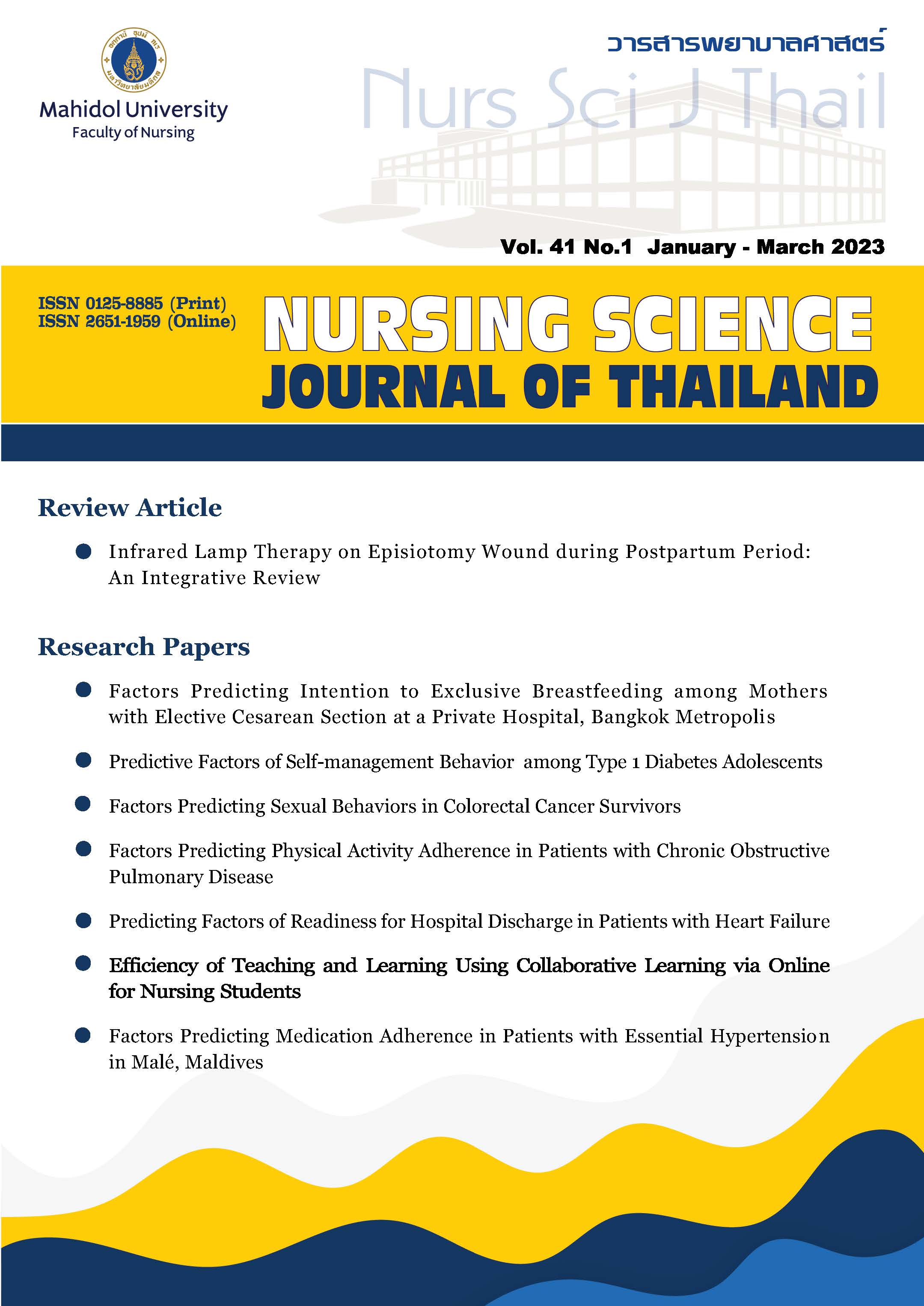Factors Predicting Sexual Behaviors in Colorectal Cancer Survivors
Main Article Content
Abstract
Purpose: To study the sexual behaviors of colorectal cancer survivors and the predictive power of perceived sexual barriers, perceived sexual self-efficacy, sexual anxiety, and sexual depression on the sexual behaviors of colorectal cancer survivors.
Design: Predictive correlational study.
Methods: The study was conducted in 85 colorectal cancer survivors aged 18 years and over who had completed cancer treatment for at least three months. Data were collected by using 6 questionnaires: a demographic, perceived sexual barriers, perceived sexual self-efficacy, sexual anxiety, sexual depression, and sexual behaviors. The data were analyzed by using descriptive and multiple regression statistics.
Main findings: The results showed that the average age of the participants was 64.6 years (SD = 7.01). The average score of participants’ sexual behaviors was medium level which was the same level as before. The results of multiple regression analysis showed that perceived sexual barriers, perceived sexual self-efficacy, sexual anxiety, and sexual depression were able to jointly explain 33% of the variance of sexual behaviors in colorectal cancer survivors. Perceived sexual self-efficacy ( = .26, p < .05), perceived sexual barriers (
= - .28, p < .01) and sexual depression (
= - .27, p < .05) were statistically significant predictors of sexual behaviors.
Conclusion and recommendations: According to the study findings, perceived sexual barriers, perceived sexual efficacy, and sexual depression were able to predict the sexual behaviors with statistical significance. Nurses and healthcare providers should assess sexual behaviors, perceived sexual barriers, perceived sexual self-efficacy, and sexual depression of the colorectal cancer survivors in order to manage these factors resulting in improvement in survivors’ sexual behaviors.
Article Details

This work is licensed under a Creative Commons Attribution-NonCommercial-NoDerivatives 4.0 International License.
Copyright Notice: Nursing Science Journal of Thailand has exclusive rights to publish and distribute the manuscript and all contents therein. Without the journal’s permission, the dissemination of the manuscript in another journal or online, and the reproduction of the manuscript for non-educational purpose are prohibited.

Disclaimer: The opinion expressed and figures provided in this journal, NSJT, are the sole responsibility of the authors. The editorial board bears no responsibility in this regard.
References
World Health Organization. Cancer [Internet]. Geneva, Switzerland: World Health Organization; 2021 [cited 2021 Oct 26]. Available from: https://www.who.int/news-room/fact-sheets/detail/cancer.
National Cancer Institute Thailand. Hospital-based cancer registry 2018. Bangkok: New Thammada Press (Thailand); 2019. 80 p. (in Thai).
Department of Medical Services, Ministry of Public Health. National cancer control programme (2018-2022) [Internet]. Bangkok: Ministry of Public Health; 2018 [cited 2020 Dec 12]. Available from: http://www.nci.go.th/th/File_download/D_index/เล่มแผนการป้องกันและควบคุมโรคมะเร็ง.pdf. (in Thai).
Centers for Disease Control and Prevention. National center for health statistics [Internet]. Atlanta: Centers for Disease Control and Prevention; 2021 [cited 2021 Nov 4]. Available from: https://www.cdc.gov/nchs/index.htm.
Macrae FA. Colorectal cancer: epidemiology, risk factors, and protective factors [Internet]. Alphen aan den Rijn, Netherlands: Wolters Kluwer; 2021 [cited 2021 Nov 4]. Available from: https://www.uptodate.com/contents/colorectal-cancer-epidemiology-risk-factors-and-protective-factors?search=%20colorectal-cancer-epidemiology-risk-factors-and-protective-factors&source=search_result&selectedTitle=1~150&usage_type=default&display_rank=1.
National Cancer Institute: NCI's dictionary of cancer terms [Internet]. Bethesda: National Cancer Institute; 2020 [cited 2021 Nov 4]. Available from: https://www.cancer.gov/publications/dictionaries/cancer-terms/def/survivor.
Averyt JC, Nishimoto PW. Addressing sexual dysfunction in colorectal cancer survivorship care. J Gastrointest Oncol. 2014;5(5):388-94. doi: 10.3978/j.issn.2078-6891.2014.059.
Masters WH, Johnson VE. Human sexual response. Boston, MA: Little, Brown and Company; 1996. 366 p.
Maslow AH. Motivation and personality. 2th ed. New York: Harper & Row; 1970. 399 p.
Conner M, Norman P. Health behaviour: current issues and challenges. Psychol Health. 2017;32(8):895-906. doi: 10.1080/08870446.2017.1336240.
Mercer CH. Sexual behaviour. Medicine (Abingdon). 2014;42(6):291-3. doi: 10.1016/j.mpmed.2014.03.005.
Almont T, Bouhnik A-D, Ben Charif A, Bendiane M-K, Couteau C, Manceau C, et al. Sexual health problems and discussion in colorectal cancer patients two years after diagnosis: a national cross-sectional study. J Sex Med. 2019;16(1):96-110. doi: 10.1016/j.jsxm.2018.11.008.
Den Oudsten BL, Traa MJ, Thong MSY, Martijn H, De Hingh IHJT, Bosscha K, et al. Higher prevalence of sexual dysfunction in colon and rectal cancer survivors compared with the normative population: a population-based study. Eur J Cancer. 2012;48(17):3161-70. doi: 10.1016/j.ejca.2012.04.004.
Milbury K, Cohen L, Jenkins R, Skibber JM, Schover LR. The association between psychosocial and medical factors with long-term sexual dysfunction after treatment for colorectal cancer. Supportive Care Cancer. 2013;21(3):793-802. doi: 10.1007/s00520-012-1582-9.
Kongwanarat M. Intimacy and knowledge, attitude, and practice about sexual behavior among cervical cancer patients at King Chulalongkorn Memorial Hospital [master’s thesis]. Bangkok: Chulalongkorn University; 2011. 96 p. (in Thai).
Pichaya P. Relationships between selected factors and sexual behavior of aging males after prostatectomy [master’s thesis]. Bangkok: Chulalongkorn University; 2004. 152 p. (in Thai).
Uthassiripanich S, Ua-Kit N. Predicting factors of sexual behaviors among male patients with myocardial infarction. Thai Journal of Cardio-Thoracic Nursing. 2011;22(2):31-43. (in Thai).
Longlalerng W, Ua-Kit N. Selected factors related to patients with myocardial infarction. Journal of Nursing Science Chulalongkorn University. 2010;22 Suppl:130-43. (in Thai).
Pender NJ. Health promotion in nursing practice. 3th ed. Stamford, Conn: Appleton & Lange; 1996. 320 p.
Snell W. The extended multidimensional sexuality questionnaire: measuring psychological tendencies associated with human sexuality. Paper presented at: the annual meeting of the Southwestern Psychological Association; 1996; Houston, TX.
Boonrueang P, Ua-Kit N. Selected factors associated with sexual function among patients with myocardial infarction after percutaneous transluminal coronary intervention. Royal Thai Navy Medical Journal. 2020;47(1):140-57. (in Thai).
Polit DF, Beck CT. Nursing research: generating and assessing evidence for nursing practice. 10th ed. Philadelphia: Wolters Kluwer; 2017. 784 p.
Steinke EE, Mosack V, Hill TJ. Sexual self-perception and adjustment of cardiac patients: a psychometric analysis. J Res Nurs. 2013;18:191-201. doi: 10.1177/1744987113477416.
Levine GN, Steinke EE, Bakaeen FG, Bozkurt B, Cheitlin MD, Conti JB, et al. Sexual activity and cardiovascular disease. Circulation. 2012;125(8):1058-72. doi: 10.1161/CIR.0b013e3182447787.
Spielberger CD, Gorsuch RL, Lushene R, Vagg PR, Jacobs GA. Manual for the state-trait anxiety inventory. Palo Alto, CA: Consulting Psychologists Press; 1983. 78 p.


